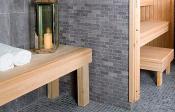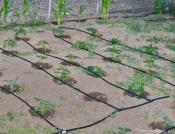Search
Login
Recommended
Automatic irrigation system - what to consider when installing
Cottage has long been a place where not only grow vegetables and fruits, but also embody their dream of paradise. To create a flower garden or a wonderful garden takes no less effort and time than to get a good crop in the beds. And it’s very disappointing when our little piece of paradise turns yellow and falls ahead of time. And due to climate change to arid and hotter, unfortunately this happens more often.
One salvation by watering. And although watering the beds is a pleasant occupation, it has become more and more difficult lately to allocate several hours a day for this. Especially when you get to the cottage once a week - on weekends. After all, there will always be more important activities. But is it not possible so that the sheep are whole and the wolves are full, i.e. and watering would be regular, and our participation in it was minimal? You can, for this, there are automatic watering systems.
Content
- Start design
- Materials and equipment for automatic irrigation system
- Nuances that you should definitely pay attention to
- Hunter automatic watering systems video
Start design

Automatic watering is a very good deal, but quite expensive. In order to not waste money in vain, you need to carefully think and plan everything. And then decide whether to fence the garden.
So, we begin to plan. We will start with the most important source of water. Do we have it in the country? If the answer is yes, then you can continue. Next, we need to find out how many cubic meters of water per hour our source can provide us. For example, for a plot of 6 acres, we need 4 m3 / h. If we have central water supply or we plan to take water from a river or pond, then most likely there will be no problems. And if we have a well or a well, then we need to know its volume. Indeed, if the volume is less than the required amount or equal to the required value, then in an hour we run the risk of being completely left without water in the summer cottage.
In addition, water from a well or a well must be checked for salt content. If they are above the norm, then over time, our flowering garden will turn into a saline desert.

Now we need to accurately calculate the area for irrigation. We take a sheet of paper (preferably in a cage), a tape measure and a pencil. The scale can be taken 1 cm \u003d 1 m. From the total area of \u200b\u200bour site, we remove the area of \u200b\u200bthe house, outbuildings, playground, pool and other irrigated places.
Next, using a tape measure, (you can use steps, accuracy to a centimeter is not important for us) we measure the area of \u200b\u200bsites for which automatic watering + do-it-yourself is necessary. We display these areas on the plan, on paper indicating the area. We will need these data to calculate the number of irrigators and their characteristics.

Now take a look at our sites and their area. It is necessary to determine in which areas one sprinkler may suffice (we are not talking about the type yet). So, for example, if we have a plot of 20 m2, then it will be enough for him to mount one point and choose a sprinkler with a coverage area of \u200b\u200b20 22 m2. Installation of two or more in one irrigation area will be more expensive, it is easier for us to provide an acceptable level of pressure in the pipes. But, if at the same time a fence or other structures fall into the irrigation zone, then it is necessary to design with several sprinklers of a smaller radius of action.
If the plot area requires two or more irrigators, then we draw a spray zone with a pair of compasses so that they intersect. Then there will be no dry zones. And do not forget about the scale.

Now we draw pipelines from the point of intake into the system. Laying should be arranged with the smallest possible flow of pipes, but try not to lay close to other communications.
Materials and equipment for automatic irrigation system

Any system, whether it is automatic watering of a lawn or beds, will need a pumping station. The power of the hydrofer is selected depending on the required pressure in the system. To provide a pressure of 4 -5 atm. the usual hydrofer for 100 cu will be quite enough, of which there are plenty in any construction supermarket. If we have a low pressure in the water supply system, then we will need a storage capacity of 0.5 m3 or more for the hydrofer.
We select the pipes at our discretion. The most inexpensive option is blue plastic. From the intake point we need a pipe 40 mm in diameter, it is laid to the first tee separating the central highway. Next, a pipe with a diameter of 32 mm or 16 mm is placed. With a little pressure, you can do with a pipe with a diameter of 32 mm. From solenoid valves, a pipe with a diameter of 16 mm.

It is necessary to design the system so that the placement of the valves is as compact as possible. It is desirable in one place, then there will not be many such wells. This will save. The number of tees, couplings and adapters, as well as their diameter, is selected depending on the project.

Next, you should choose irrigators:
- For watering the garden, the best option is drip irrigation. For it, we need drip tubes for the length of the beds, drip fittings and an injector. The injector can be delivered with time. It is needed to supply fertilizer.
- It is best to use rotary sprinklers (PGP) for watering the lawn. They cover a large area during irrigation, and during off hours are compact and invisible.
- Static or fan sprinklers are suitable both for lawns with a small area (up to 8 m2) and for flower beds.

And most importantly, without which the system will not be automatic - the controller. This is a programmable device with many features. The price of the controller depends on the number of functions.
Nuances that you should definitely pay attention to

When designing and selecting equipment + for automatic watering, please note:
- for drip irrigation systems, such as automatic irrigation of a greenhouse or beds, pressure regulators are required;
- be sure to provide a mechanical filter to the pumping station, this will protect the sprinklers from clogging. And installation before the hydrosphere will prevent the pressure drop on the filter;
- there are wireless solenoid valves for irrigation systems, if funds allow them to better use them. The difference in price is not so great, because already during installation, there is no need to lay the cable. And in the future, such systems are easier to maintain and repair (for example, the wires are not oxidized).
This topic is extensive, and it’s impossible to cover everything at a time. Moreover, manufacturers are constantly working to improve the system. The main thing is to understand how it works. And the installation does not have to be completed in one season, the system as a designer, it can be assembled in parts.





